- WTFC Dashboard
- Financials
- Filings
-
Holdings
- Transcripts
- ETFs
- Insider
- Institutional
- Shorts
-
CORRESP Filing
Wintrust Financial (WTFC) CORRESPCorrespondence with SEC
Filed: 15 Mar 10, 12:00am
 | SIDLEY AUSTINllp ONE SOUTH DEARBORN CHICAGO, IL 60603 (312) 853 7000 (312) 853 7036 FAX | BEIJING BRUSSELS CHICAGO DALLAS FRANKFURT GENEVA HONG KONG LONDON LOS ANGELES FOUNDED 1866 | NEW YORK PALO ALTO SAN FRANCISCO SHANGHAI SINGAPORE SYDNEY TOKYO WASHINGTON, D.C. |
| Re: | Wintrust Financial Corporation File No. 000-21923 Form 10-K for the fiscal year ended December 31, 2008 Definitive Schedule 14A filed April 20, 2009 Form 10-Q for the period ended March 31, 2009 Form 10-Q for the period ended June 30, 2009 Form 10-Q for the period ended September 30, 2009 |

| Sincerely, | ||||
| /s/ Lisa J. Reategui | ||||
| Lisa J. Reategui | ||||
| cc: | Edward J. Wehmer, Wintrust Financial Corporation David A. Dykstra, Wintrust Financial Corporation David L. Stoehr, Wintrust Financial Corporation |
| Re: | Wintrust Financial Corporation File No. 000-21923 Form 10-K for the fiscal year ended December 31, 2009 Definitive Schedule 14A filed April 20, 2009 Form 10-Q for the period ended March 31, 2009 Form 10-Q for the period ended June 30, 2009 Form 10-Q for the period ended September 30, 2009 |
| • | the Company is responsible for the adequacy and accuracy of the disclosure in the filings; | ||
| • | Staff comments or changes to disclosure in response to Staff comments do not foreclose the Commission from taking any action with respect to the filing; and | ||
| • | the Company may not assert Staff comments as a defense in any proceeding initiated by the Commission or any person under the federal securities laws of the United States. |
| By: | /s/ David L. Stoehr | |||
| Executive Vice President and Chief Financial Officer |
 | SIDLEY AUSTINllp | BEIJING | NEW YORK | |||
| ONE SOUTH DEARBORN | BRUSSELS | PALO ALTO | ||||
| CHICAGO, IL 60603 | CHICAGO | SAN FRANCISCO | ||||
| (312) 853 7000 | DALLAS | SHANGHAI | ||||
| (312) 853 7036 FAX | FRANKFURT | SINGAPORE | ||||
| GENEVA | SYDNEY | |||||
| HONG KONG | TOKYO | |||||
| LONDON | WASHINGTON, D.C. | |||||
| LOS ANGELES | ||||||
| FOUNDED 1866 |
| Re: | Wintrust Financial Corporation File No. 000-21923 Form 10-K for the fiscal year ended December 31, 2008 Definitive Schedule 14A filed April 20, 2009 Form 10-Q for the period ended March 31, 2009 Form 10-Q for the period ended June 30, 2009 Form 10-Q for the period ended September 30, 2009 |
| 1. | As we requested in comment 14 of our comment letter to you dated September 29, 2009, please undertake in your future filings to provide, throughout the filing, separate data and analysis regarding commercial real estate loans. For instance, separate data and analysis of commercial real estate loans from commercial loans rather than aggregating them. Likewise, in your table and analysis of Past Due Loans and Non-Performing Assets, on pages 57-58 separate data and analysis of commercial real estate loans from consumer loans and other loans rather than aggregating them. Please explain in your |

| MD&A the reason(s) why in operating your business and in analyzing and managing your loan portfolio, you do not distinguish between commercial real estate loans and other commercial loans and do not distinguish between commercial real estate loans and consumer loans given their different characteristics including risks and returns. If the Company has specific reasons for not disaggregating this information, please supplementally advise the staff. |
| 2. | As we requested in comment 1 of our letter dated February 18, 2010, comment 3 of our letter to you dated January 20, 2010, comment 25 of our comment letter to you dated September 29, 2009, please undertake in your future filings to revise your proposed disclosure in the “Overview” section of the Managements Discussion and Analysis with meaningful disclosure and analysis relating toyour business condition, financial condition and results of operations consistent with Release No. 33-8350. As we have repeatedly requested, your revisions to the section you entitled “The Current Economic Environment” should include, but not limited to, the following: |

| • | quantify and analyze the trends in commercial real estate prices, commercial real estate sales and new construction inyour market areas and its effect on your commercial real estate loans; | ||
| • | quantify and analyze the trends in the amount and percentage ofyour loan portfolio that is commercial real estate loans and analyze the consequences of these loans being concentrated in the Chicago and Milwaukee metropolitan areas; and | ||
| • | revise the bullet points on page 1-2 to quantify and analyze the extent to which your defaults and foreclosures, losses, allowance for loan losses, net charge offs, non-performing loans and other real estate owned are attributable to commercial real estate loans. |

| 3. | We note your proposed response to our comment 2 of our letter to you dated February 18, 2010. Please undertake in your future filings to revise the fifth paragraph on page 3 of your proposed revisions to quantify the net amount by which you increased or decreased each particular type of loan to which you refer. |

| 4. | We note your proposed response to comment 5 of our letter to you dated February 18, 2010. Please undertake in your future filings to revise the second paragraph as follows: |
| • | as we requested, revise the first sentence of the second paragraph to explain that the net income would have been a loss of $22 million instead of a gain of $73 million but for a one time non-cash gain based on your evaluation that the fair value of the loans you acquired from AIG in July 2009 for which you paid $679 million were worth $156 million more than you paid for them; | ||
| • | revise your proposed new second sentence in the second paragraph that refers to commercial real estate loans, residential real estate construction; and business loans to commercial and industrial companies to disclose the amount and percent of your losses attributable to each category of loans; and | ||
| • | revise the proposed new last sentence of the last paragraph to identify the specific “challenges” to which you refer on which you based your decision to significantly increase your allowance for credit losses. |

| 5. | We note your proposed response, in your Exhibit 4, to comment 4 of our letter to you dated February 18, 2010. As we requested, undertake in your future filings to: |
| • | provide more detail in the second paragraph regarding the legal basis for your security interest in these loans; and | ||
| • | as we requested, explain in more detail, in the fourth paragraph, what consents are required and from whom (banks that issued the letter of credit whose consent is required to make you the beneficiary and brokerage firms that hold accounts of insured persons that are to be assigned to you as collateral). |

| 6. | We note your response to prior comment 8. In your response you indicate that you consider the strength of guarantees and the ability of the borrower to provide value relating to those guarantees in determining the ultimate charge-off or reserve associated with any impaired loans. Please address how the Company evaluates the following in the determination of the collateral value and the appropriate level of charge-offs or provisions required: |

| • | Tell us how the company evaluates the strength of the guarantor, including the specific type of information reviewed, how current and objective the information reviewed is, and how often the review is performed; | ||
| • | Quantify the number and dollar amount of impaired loans in which the Company’s carrying value is in excess of the appraised value but not classified as impaired due to the existence of guarantees; and | ||
| • | Tell us how often the Company has pursued and successfully collected from the guarantor. Tell us the dollar amount of these guarantor collections recognized in each reporting period of fiscal 2009. |
| 7. | We note that you do not consider restructured loans in your determination of nonperforming loans. Tell us and revise future filings to provide the following disclosures: |
| • | Clarify why you do not include such loans as nonperforming; |

| • | Discuss how you identify loans to be restructured; | ||
| • | Quantify the amount of restructured loans (by loan type), and aggregate the amounts in accrual and nonaccrual status; | ||
| • | Quantify the types of concessions you have made (e.g. reduction of interest rate, payment extensions, forgiveness of principal, forbearance or other actions) and discuss your success with the different types of concessions (qualitatively and quantitatively); | ||
| • | Disclose your policy regarding how many payments the borrower needs to make on the restructured loans before you return the loan to accrual status; | ||
| • | Discuss how restructured loans impact the timing of the recording of the allowance for loan losses. For example, discuss whether the largest effect of the loan modification is recorded during the period of the modification or whether the modification has largely been reserved for under your normal reserving methodology; and | ||
| • | If impairment is measured based on the present value of expected cash flows, disclose your policy election regarding how the entire change in present value is reflected in the financial statements. For example, disclose whether the amount is recorded entirely within the provision for loan losses or whether a portion reflecting the amount attributable to the passage of time is recorded as interest income. To the extent that part of the amount is reflected within interest income, the amount of interest income recognized should be disclosed. Refer to ASC 310-10-45. |


| Sincerely, | ||||
| /s/ Lisa J. Reategui | ||||
| Lisa J. Reategui | ||||
| cc: | Edward J. Wehmer, Wintrust Financial Corporation David A. Dykstra, Wintrust Financial Corporation David L. Stoehr, Wintrust Financial Corporation |
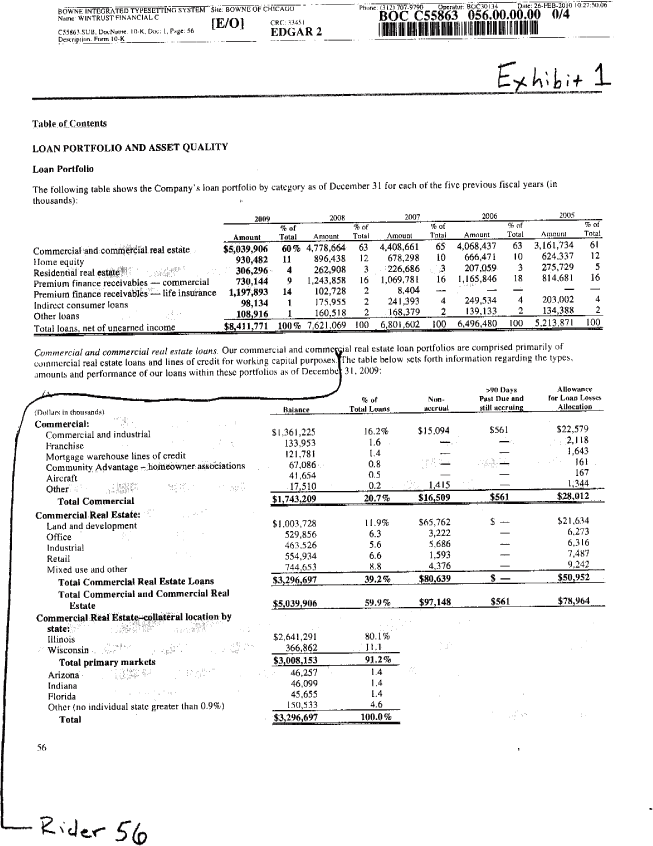
| able of.Contents .OAN PORTFOLIO AND ASSET QUALITY jOan Portfolio rhe following table shows the Company’s loan portfolio by category as of December 31 for each of the five previous fiscal years (in housands): > 20(W 200S 2007 2006 200-1i %7f *rf *of %»f *°f Amount Total Amount TnUI Anroilnl Total Amnunt Tolal Amount Tntal. Commercial and cordial real estate $5,039,906 60% 4,778,664 63 4,408,661 65 4,068,437 63 3,161,734 61 Home equity 930,482 11 896,438 12 678,298 10 666,471 10 624,337 12 residential real estate^ 306,296 4 262,908 3 226,686 .3 2(,7,059 3 275,729 5 Premium finance receivables-commercial 730,144 9 1,243,858 16 1,069,781 16 1,165,846 18 814,681 16 Premium finance receivables —life insurance 1,197,893 14 102,728 2 8,404 - — — — , .. i Ufi \\A 1 I7S OSS 1 24 393 4 249,534 4 203,002 4 Indirect consumer loans 98,134 1 I o,v33 / f!;,,,,,, , ,,n\\i -> i™«b-> Other loans 108,916 1 160.518 2 168,379 2 119,133 2 134,388 2 Total loans, net of unearned income $8.411.771 100% 7.621.069 100 6.801.602 100 6,496,480 100 5.213,871 100 Commercial and commercial real estate loans. Our commercial and commercial real estate loan portfolios are comprised primarily of commercial real estate loans and lines of credit for working capital purposesTI’he table below sets forth information regarding the types, amounts and performance of our loans within these portfolios as of Decembel 31, 2009: ,. J >yo Days Allowanix “ ,, -’i,iiimii.m% yr N(in___p,,st Due and Tor Loan Losses (Dolta in .hounds) Balance Total Loans acmml still accruinE, Allocation Commercial: .,,,,,,. «.r,,it,c-?n Commercial and industrial $1,361,225 16.2% $15,094 $561 $22,579 Franchise 133.953 1.6 — - .2J18 Mortgage warehouse lines of credit 121,781 1.4 > Community Advantage -homeowner associations 67,086 0.8 ,!¦’¦. — : f:^ «’ Aircraft 41,654 0.5 — - 167 Other::;: 17.510 0.2 1.415 = L34i___Total Commercial $1.743.209 20.7% $16,509 $561 $28,012 Commercial Real Estate: Land and development $1,003,728 11.9% $65,762 $- $21,634 Office 529,856 6.3 3,222 — 6,273 Industrial 463.526 5.6 5,686 — 6,316 Retail 554,934 6.6 1,593 — 7,487 Mixed use and other 744,653 88 4,376 9,242 Total Commercial Real Estate Loans $3,296,697 39.2% $80,639 $ — $50,952— Total Commercial and Commercial Real Es,ate $5.039,906 59.9% $97.148 $561 $78,964 Commercial R*alE^tate^;$a;teral location by state: Illinois $2,641,291 80.1% ‘Wisconsin C:”’ ,,:!•;’’. 366,862 11.1 Total primary markets $3,008,153 91,2% Arizona 46,257 1.4 Indiana 46,099 1.4 Florida 45,655 1.4 Other (no individual state greater than 0.9%) 150,533 4.6 Total $3,296,697 100.0% 56 |
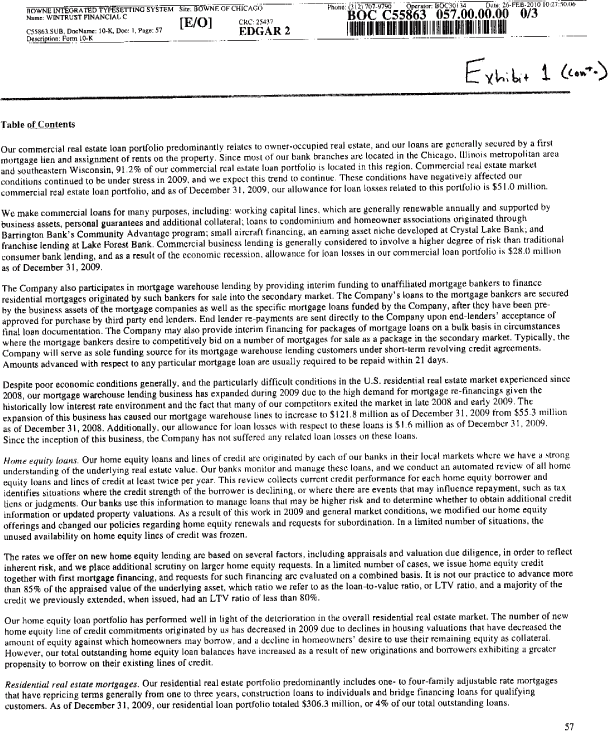
| Table of .Contents Our commercial real estate loan portfolio predominantly relates to owner-occupied real estate, and our loans are generally secured by a first mortgage lien and assignment of rents on the property. Since most of our bank branches are located in the Chicago, llhnois metropolitan area and southeastern Wisconsin, 91.2% of our commercial real estate loan portfolio is located in this region. Commercial real estate market conditions continued to be under stress in 2009, and we expect this trend to continue. These conditions have negatively affected our commercial real estate loan portfolio, and as of December 31, 2009, our allowance for loan losses related to this portfolio is $51,0 million. We make commercial loans for many purposes, including: working capital lines, which are generally renewable annually and supported by business assets, personal guarantees and additional collateral; loans to condominium and homeowner associations originated through Barrington Bank’s Community Advantage program; small aircraft financing, an earning asset niche developed at Crystal Lake Bank; and franchise lending at Lake Forest Bank. Commercial business lending is generally considered to involve a higher degree of risk than traditional consumer bank lending, and as a result of the economic recession, allowance for loan losses in our commercial loan portioho is $28.0 million as of December 31, 2009. The Company also participates in mortgage warehouse lending by providing interim funding to unaffilialed mortgage bankers to finance residential mortgages originated by such bankers for sale into the secondary market. The Company’s loans to the mortgage bankers are secured by the business assets of the mortgage companies as well as the specific mortgage loans funded by the Company, after they have been pre-approved for purchase by third party end lenders. End lender re-payments are sent directly to the Company upon end-lenders acceptance ol final loan documentation. The Company may also provide interim financing for packages of mortgage loans on a bulk basis in circumstances where the mortgage bankers desire to competitively bid on a number of mortgages for sale as a package in the secondary market. Typically, the Company will serve as sole funding source for its mortgage warehouse lending customers under short-term revolving credit agreements. Amounts advanced with respect to any particular mortgage loan are usually required to be repaid within 21 days. Despite poor economic conditions generally, and the particularly difficult conditions in the U.S. residential real estate market experienced since 2008, our mortgage warehouse lending business has expanded during 2009 due to the high demand for mortgage re-financings given the historically low interest rate environment and the fact that many of our competitors exiled the market in late 2008 and early 2009. The expansion of this business has caused our mortgage warehouse lines to increase to $121.8 million as of December 31, 2009 from $55.3 million as of December 31, 2008. Additionally, our allowance for loan losses with respect to these loans is $1.6 million as of December 31, 20(W. Since the inception of this business, the Company has not suffered any related loan losses on these loans. Home equity loans Our home equity loans and lines of credit are originated by each of our banks in their local markets where we have a strong understanding of the underlying real estate value. Our banks monitor and manage these loans, and we conduct an automated review ot all home equity loans and lines of credit at least twice per year. This review collects current credit performance for each home equity borrower and identifies situations where the credit strength of the borrower is declining, or where there are events that may influence repayment, such as tax liens or judgments. Our banks use this information to manage loans t hat may be higher risk and to determine whether to obtain additional credit information or updated property valuations. As a result of this work in 2009 and general market conditions, we modified our home equity offerings and changed our policies regarding home equity renewals and requests for subordination. In a limited number of situations, the unused availability on home equity lines of credit was frozen. The rates we offer on new home equity lending arc based on several factors, including appraisals and valuation due diligence, in order to reflect inherent risk, and we place additional scrutiny on larger home equity requests. In a limited number of eases, we issue home equity credit together with first mortgage financing, and requests for such financing arc evaluated on a combined basis. It is not our practice to advance more than 85% of the appraised value of the underlying asset, which ratio we refer to as the loan-to-valuc ratio, or LTV ratio, and a majority ot the credit we previously extended, when issued, had an LTV ratio of less than 80%. Our home equity loan portfolio has performed well in light of the deterioration in the overall residential real estate market. The number of new home equity line of credit commitments originated by us has decreased in 2009 due to declines in housing valuations that have decreased the amount of equity against which homeowners may borrow, and a decline in homeowners’ desire to use their remaining equity as collateral. However, our total outstanding home equity loan balances have increased as a result of new originations and borrowers exhibiting a greater propensity to borrow on their existing lines of credit. Residential real estate mortgages. Our residential real estate portfolio predominantly includes one- to four-family adjustable rate mortgages that have repricing terms generally from one to three years, construction loans to individuals and bridge financing loans for qualifying customers. As of December 31, 2009, our residential loan portfolio totaled $306,3 million, or 4% of our total outstanding loans, 57 |
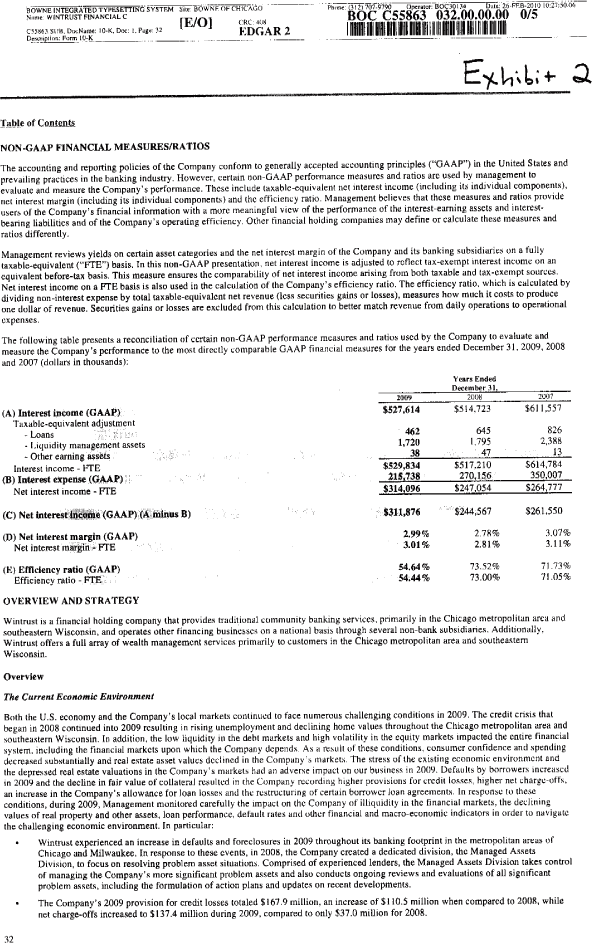
| Table of CoMents NON-GAAP FINANCIAL MEASURES/RATIOS The accounting and reporting policies of the Company conform to generally accepted accounting principles (“GAAP”) in the United Stales and prevailing practices in the banking industry. However, certain non-GAAP performance measures and ratios are used by management to evaluate and measure the Company’s performance. These include taxable-equivalent net interest income (including its individual components), net interest margin (including its individual components) and the efficiency ratio. Management believes that these measures and ratios provide users of the Company’s financial information with a more meaningful view of the performance of the interest-earning assets and interest-bearing liabilities and of the Company’s operating efficiency. Other financial holding companies may define or calculate these measures and ratios differently. Management reviews yields on certain asset categories and the net interest margin of the Company and its banking subsidiaries on a fully taxable-equivalent (“FTE”) basis. In this non-GAAP presentation, net interest income is adjusted to reflect tax-exempt interest income on an equivalent before-tax basis. This measure ensures the comparability of net interest income arising from both taxable and tax-exempt sources. Net interest income on a FTE basis is also used it) the calculation of the Company’s efficiency ratio. The efficiency ratio, which is calculated by dividing non-interest expense by total taxable-equivalent net revenue (less securities gains or losses), measures how much it costs to produce one dollar of revenue. Securities gains or losses are excluded from this calculation to better match revenue from daily operations to operational expenses. The following table presents a reconciliation of certain non-GAAP performance measures and ratios used by the Company to evaluate and measure the Company’s performance to the most directly comparable GAAP financial measures for the years ended December 31, 2009, 2008 and 2007 (dollars in thousands): Years Ended December 31, 2IIIW 2008 2007 (A) Interest income (GAAP) «27.6M $514,723 $611,557 Taxable-equivalent adjustment -Loans 4«2 645 826 -Liquidity management assets 1.720 1,795 2’^ — Other earning assets —3§ ¦¦/¦, .47 ___; 13— Interest income-FTE $529,834 «”.210 $614,784 (B) Interest expense (GAAP) )W Ht,738 270,156; 3S0’QQ7 Net interest income-FTE $314,096 $247,054 $264,777 Net tatenrtfflUt’’(GAAP) (A minus B) «U,87« $244,567 $261,550 Net Interest margin (GAAP) 2.99% 2.78% 3.07% Net interest mar|ffl;iFTE 3.01% 2.81% 3.11% (E) Efficiency ratio (GAAP) 54,64% 73.52% 71.73% Efficiency ratio-.FTE!- 54.44% 73.00% 71.05% OVERVIEW AND STRATEGY Wintrust is a financial holding company that provides traditional community banking services, primarily in the Chicago metropolitan area and southeastern Wisconsin, and operates other financing businesses on a national basis through several non-bank subsidiaries. Additionally, Wintrust offers a full array of wealth management services primarily to customers in the Chicago metropolitan area and southeastern Wisconsin. Overview The Current Economic Environment Both the U.S. economy and the Company’s local markets continued to face numerous challenging conditions in 2009. The credit crisis that began in 2008 continued into 2009 resulting in rising unemployment and declining home values throughout the Chicago metropolitan area and southeastern Wisconsin. In addition, the low liquidity in the debt markets and high volatility in the equity markets impacted the entire financial system, including the financial markets upon which the Company depends. As a result of these conditions, consumer confidence and spending decreased substantially and real estate asset values declined in the Company’s markets. The stress of t he existing economic environment and the depressed real estate valuations in the Company’s markets had an adverse impact on our business in 2009. Defaults by borrowers increased in 2009 and the decline in fair value of collateral resulted in the Company recording higher provisions for credit losses, higher net charge-offs, an increase in the Company’s allowance for loan losses and the restructuring of certain borrower loan agreements. In response to these conditions, during 2009, Management monitored carefully the impact on the Company of illiquidity in the financial markets, the declining values of real property and other assets, loan performance, default rates and other financial and macro-economic indicators in order to navigate the challenging economic environment. In particular:• Wintrust experienced an increase in defaults and foreclosures in 2009 throughout its banking footprint in the metropolitan areas of Chicago and Milwaukee. In response to these events, in 2008, the Company created a dedicated division, the Managed Assets Division, to focus on resolving problem asset situations. Comprised of experienced lenders, the Managed Assets Division takes control of managing the Company’s more significant problem assets and also conducts ongoing reviews and evaluations of all significant problem assets, including the formulation of action plans and updates on recent developments. The Company’s 2009 provision for credit losses totaled $167.9 million, an increase of $110.5 million when compared to 2008, while npt rharoenffs increased tn S1T7.4 million durine 2009. comoared to onlv $37.0 million for 2008. |
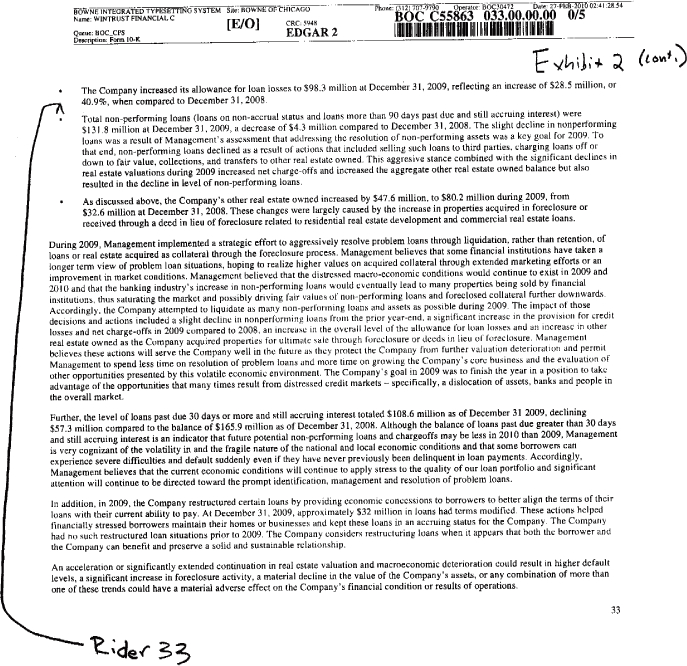
| The Company increased its allowance for loan losses to $98.3 million at December 31, 2009, reflecting an increase of $28.5 million, or — 40.9%, when compared to December 31, 2008. / ¦ Total non-performing loans (loans on non-accrual status and loans more than 90 days past due and still accruing interest) were / $13 I 8 million at December 31, 2009, a decrease of $4.3 million compared to December 31, 2008. The slight decline in nonpertorming / loans was a result of Management’s assessment that addressing the resolution of non-performing assets was a key goal for 2009 I o / thai end non-performing loans declined as a result of actions that included selling such loans to third parties, charging loans off or / down to’fair value collections, and transfers to other real estate owned. This aggresive stance combined with the significant declines in | real estate valuations during 2009 increased net charge-offs and increased the aggregate other real estate owned balance but also I resulted in the decline in level of non-perform i ng loans. I• As discussed above, the Company’s other real estate owned increased by $47.6 million, to $80.2 million during 2009, from I $32.6 million at December 31, 2008. These changes were largely caused by the increase in properties acquired in foreclosure or I received through a deed in lieu of foreclosure related to residential real estate development and commercial real estate loans. I During 2009, Management implemented a strategic effort to aggressively resolve problem loans through liquidation, rather than retention, of / loans or real estate acquired as collateral through the foreclosure process. Management believes that some financial institutions have taken a I longer term view of problem loan situations, hoping to realize higher values on acquired collateral through extended marketing efforts or an I improvement in market conditions. Management believed that the distressed macro-economic conditions would continue to exist in 2U09 and I 2010 and that the banking industry’s increase in non-performing loans would eventually lead to many properties being sold by financial i institutions, thus saturating the market and possibly driving fair values of non-performing loans and foreclosed collateral further downwards. / Accordingly the Company attempted to liquidate as many non-performing loans and assets as possible during 2009. The impact of those / decisions and actions included a slight decline in nonperforming loans from the prior year-end, a significant increase in the provision for credit I losses and net charge-offs in 2009 compared to 2008, an increase in the overall level of the allowance for loan losses and an increase in other I real estate owned as the Company acquired properties for ultimate sale through foreclosure or deeds in lieu of loreclosure. Management I believes these actions will serve the Company well in (he future as (hey protect the Company from turther valuation deterioration and permit I Management to spend less time on resolution of problem loans and more time on growing the Company’s core business and the evaluation of I other opportunities presented by this volatile economic environment. The Company’s goal in 2009 was to finish the year in a position to lake I advantage of the opportunities that many times result from distressed credit markets — specifically, a dislocation of assets, banks and people in I the overall market. I Further the level of loans past due 30 days or more and still accruing interest totaled $108.6 million as of December 31 2009, declining I $57 3 million compared to the balance of $165.9 million as of December 31, 2008. Although the balance of loans past due greater than 30 days I and still accruing interest is an indicator that future potential non-performing loans and chargeoffs may be less in 2010 than 2009, Ma nagement I is very cognizant of the volatility in and the fragile nature of the national and local economic conditions and that some borrowers can I experience severe difficulties and default suddenly even if they have never previously been delinquent in loan payments. Accordingly, I Management believes that the current economic conditions will continue to apply stress to the quality of our loan portfolio and significant I attention will continue to be directed toward the prompt identification, management and resolution of problem loans. / In addition, in 2009, the Company restructured certain loans by providing economic concessions to borrowers to better align the terms of their I loans with their current ability to pay. At December 31, 2009, approximately $32 million in loans had terms modified. These actions helped I financially stressed borrowers maintain their homes or businesses and kept these loans in an accruing status for the Company. The Company I had no such restructured loan situations prior to 2009. The Company considers restructuring loans when it appears that both the borrower and the Company can benefit and preserve a solid and sustainable relationship. An acceleration or significantly extended continuation in real estate valuation and macroeconomic deterioration could result in higher default levels, a significant increase in foreclosure activity, a material decline in the value of the Company’s assets, or any combination of more than one of these trends could have a material adverse effect on the Company’s financial condition or results of operations. |
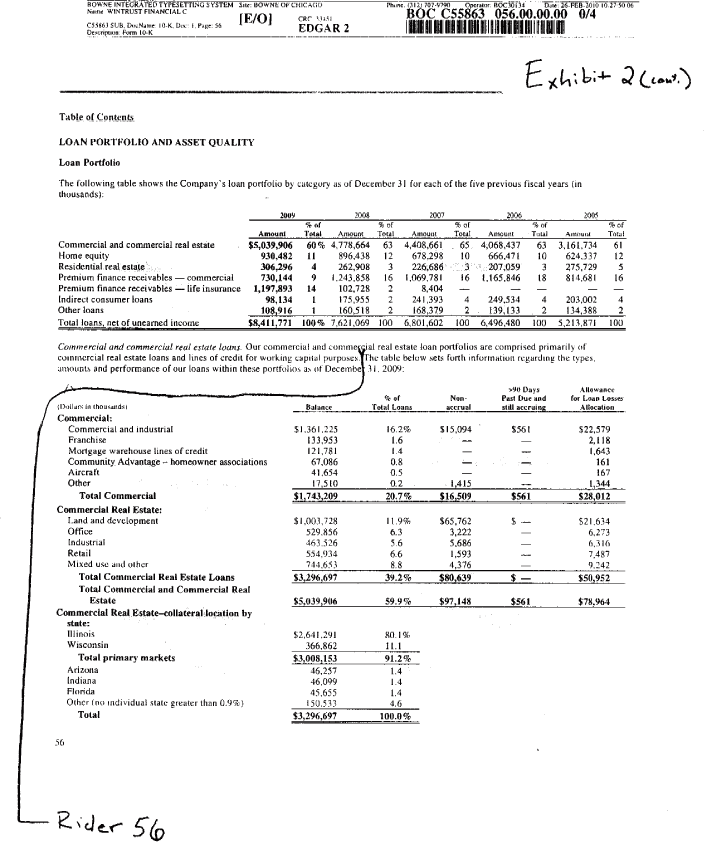
| Table of Contents LOAN PORTFOLIO AND ASSET QUALITY Loan Portfolio The following table shows the Company’s loan portfolio by category as of December 31 for each of the five previous fiscal years (in thousands); 20JW 2008 2007 2006 2005% of % of % of % of % of Amount Total Amount Total Amount Total Amount Tntal Amount Total Commercial and commercial real estate $5,039,906 60% 4,778,664 63 4,408,661 65 4,068,437 63 3,161,734 61 Home equity 930,482 11 896,438 12 678,298 10 666,471 10 624,337 12 Residential real estate/, 306,296 4 262,908 3 226,686 :::3 :::207,059 3 275,729 5 Premium finance receivables — commercial 730,144 9 1,243,858 16 1,069,781 16 1,165,846 18 814,681 16 Premium finance receivables — life insurance 1,197,893 14 102,728 2 8,404 — — — — — Indirect consumer loans 98,134 1 175,955 2 241,393 4 249,534 4 203,002 4 Other loans 108,916 I 160,518 2 168,379 2 139,133 , 2 134,388 2 Total loans, net of unearned income $8,411,771 100% 7,621,069 100 6,801,602 100 6,496,480 100 5,213,871 100 Commercial and commercial real estate loans. Our commercial and commercial real estate loan portfolios are comprised primarily of commercial real estate loans and lines of credit for working capital purposesTrhe table below sets forth information regarding the lypes, amounts and performance of our loans within these portfolios as of December 3 1, 2009: J ^ IMIi ‘ ^^^^^ . ^S >yit Days Allowance f % of Non- Past Due and for Loan Losses / (Dollars in thousand*) jtalancc Total Loans accrual still accruing Allocation J Commercial: / Commercial and industrial SI,361.225 16.2% $15,094 ‘ $561 $22,579 / Franchise 133,953 1.6 — — 2,118 J Mortgage warehouse lines of credit 121,781 1.4 — — 1,643 I Community Advantage - homeowner associations 67,086 0.8 -— —^ 161 I Aircraft 41,654 0.5 — — 167 I Other 17,510 0.2 1,415 — 1,344 Total Commercial $1,743,209 20,7% $16,509 $561 $28,012 Commercial Real Estate: Land and development $1,003,728 11.9% $65,762 $ — $21,634 Office 529,856 6.3 3,222 — 6,273 Industrial 463.526 5,6 5,686 — 6,316 Retail 554,934 6.6 1,593 — 7,487 Mixed use and other 744,653 O 4,376 — 9.242 Total Commercial Real Estate Loans $3,296,697 39.2% $80,639 $ — $50,952 Total Commercial and Commercial Real Estate $5,039,906 59.9% $97,148 $561 $78,964 I Commercial Real Estate-collateral location by I state: j Illinois $2,641,291 80.1% J Wisconsin 366,862 11.1 I Total primary markets $3,008,153 91,2% J Arizona 46,257 1.4 Indiana 46,099 1.4 Florida 45,655 1.4 Other (no individual stale greater than 0.9%) 150,533 4.6 Total $3,296,697 100.0% 56 |
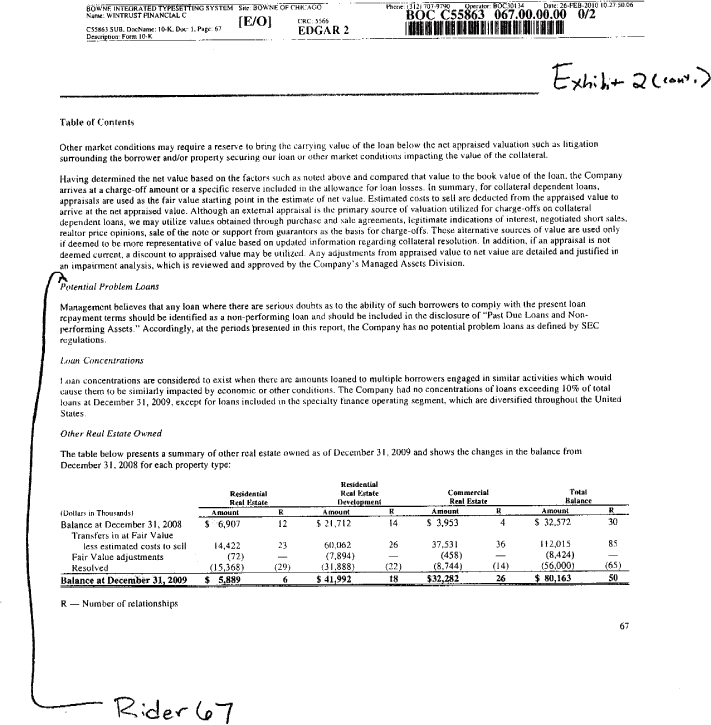
| Table of Contents Other market conditions may require a reserve to bring (lie carrying value of the loan below the net appraised valuation such as litigation surrounding the borrower and/or property securing our loan or other market conditions impacting the value of the collateral. Having determined the net value based on the factors such as noted above and compared that value to the book value of the loan, the Company arrives at a charge-off amount or a specific reserve included in the allowance for loan losses. In summary, for collateral dependent loans, appraisals are used as the fair value starting point in the estimate of net value. Estimated costs to sell arc deducted from the appraised value to arrive at the net appraised value. Although an external appraisal is (he primary source of valuation utilized for charge-offs on collateral dependent loans, we may utilize values obtained through purchase and sale agreements, legitimate indications of interest, negotiated short sales. realtor price opinions, sale of the note or support from guarantors as the basis for charge-offs. These alternative sources of value are used only if deemed lobe more representative of value based on updated information regarding collateral resolution. In addition, if an appraisal is not deemed current, a discount to appraised value may be utilized. Any adjustments from appraised value to net value are detailed and justified in an impairment analysis, which is reviewed and approved by the Company’s Managed Assets Division. / Potential Problem Loans Management believes that any loan where there are serious doubts as to the ability of such borrowers to comply with the present loan repayment terms should be identified as a non-performing loan and should be included in the disclosure of “Past Due Loans and Non-performing Assets.” Accordingly, at the periods presented in this report, the Company has no potential problem loans as defined by SEC regulations. I Loan Concentrations I I .oan concentrations are considered to exist when there are amounts loaned to multiple borrowers engaged in similar activities which would / cause them to be similarly impacted by economic or other conditions. The Company had no concentrations of loans exceeding 10% of total I loans at December 3 1, 2009, except for loans included in the specialty finance operating segment, which arc diversified throughout the United I Stales I Other Real Estate Owned I The table below presents a summary of other real estate owned as of December 31,2009 and shows the changes in the balance from I December 31, 2008 for each property type: I Residential I Residential Real Estate Commercial Total Real Estate Development Real Estate Balance (Dollars in Thousands) Amount R Amount R Amount R Amount ___R Balance at December 31,2008 $6,907 12 $21,7(2 14 $’3,953 4 $32,572 30 Transfers in at Fair Value less estimated costs lo sell 14,422 23 60,062 26 37,531 36 112,015 85 Fair Value adjustments (72) — (7,894) — (458) — (8,424) — Resolved (15,368) (29) (31,888) (22) (8,744) (14) (56,000) (65) Balance at December 31,2009 $ 5,889 6 $41,992 18 $32,282 26 $ 80,163 50 — ¦ I R— Number of relationships 67 |
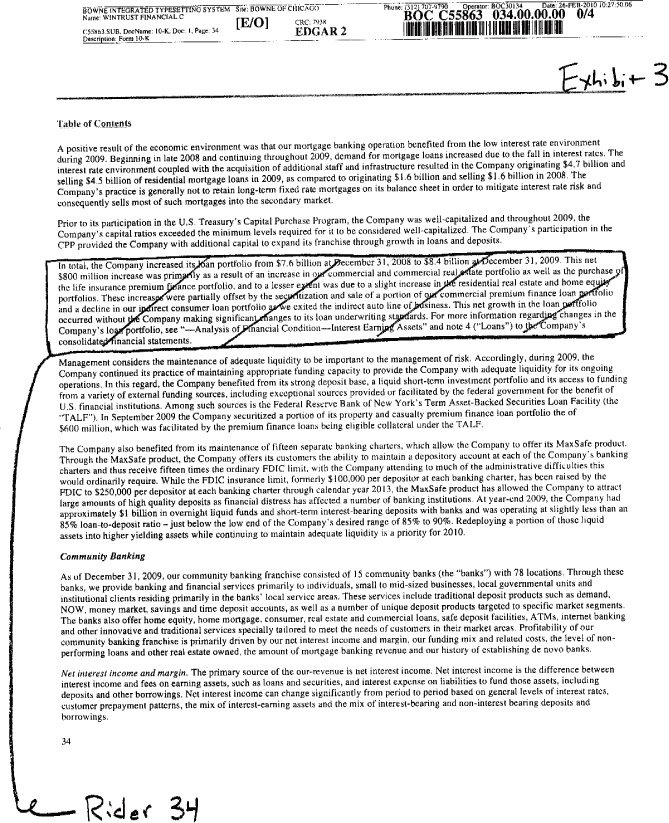
| Table of Contents A positive result of the economic environment was that our mortgage banking operation benefited from (he low interest rate environment during 2009 Beginning in late 2008 and continuing throughout 2009, demand for mortgage loans increased due to the fall in interest rales. I he interest rate environment coupled with the acquisition of additional staff and infrastructure resulted in the Company originating $4,7 billion and selling $4 5 billion of residential mortgage loans in 2009, as compared to originating $1.6 billion and selling $1.6 billion in 2008. The Company’s practice is generally not to retain long-term fixed rate mortgages on its balance sheet in order to mitigate interest rale risk and consequently sells most of such mortgages into the secondary market. Prior to its participation in the U.S. Treasury’s Capital Purchase Program, the Company was well-capitalized and throughout 2009, the Company’s capital ratios exceeded the minimum levels required for it to be considered well-capitalized. The Company’s participation in the CPP provided the Company with additional capital to expand its franchise through growth in loans and deposits. (“‘in total, the Company increased its^Oan portfolio from $7.6 billion at^ecember 31, 2008 to $8.4 billiona*<December 31, 2009. This net $800 million increase was primarily as a result of an increase in mw’eommercial and commercial reaj^Tate portfolio as well as the purchase^ the life insurance premium f>l£nce portfolio, and to a lesser eyfil was due to a slight increase uyt* residential real estate and home equj*«r portfolios These increasa.fwere partially offset by the secufuization and sale of a portion ofWcommercial premium finance loano»iTfolio and a decline in our irytirect consumer loan portfolio ai/we exited the indirect auto line oHxfsiness. This net growth in the loanm»fTfolio occurred withoutj)<6Company making significanLyffianges to its loan underwriting stajatfards. For more information regard^changes in the Company’s IrWportfolio, see “—Analysis of^fnancial Condition—Interest Earnyf Assets” and note 4 (“Loans”) toJfrfCompany s i consolidatej**financial statements. jf -^^»^ j^Management considers the maintenance of adequate liquidity to be important to the management of risk. Accordingly, during 2009, the / Company continued its practice of maintaining appropriate funding capacity to provide the Company with adequate liquidity for its ongoing / operations In this regard, the Company benefited from its strong deposit base, a liquid short-term investment portfolio and its access to funding / from a variety of external funding sources, including exceptional sources provided or facilitated by the federal government for the benefit of / U.S. financial institutions. Among such sources is the Federal Reserve Bank of New York’s Term Asset-Backed Securities Loan Facility (the / “TALF”). In September 2009 the Company sectiritized a portion of its property and casualty premium finance loan portfolio the of / $600 million, which was facilitated by the premium finance loans being eligible collateral under the TALF. / The Company also benefited from its maintenance of fifteen separate banking charters, which allow the Company to offer its MaxSafe product. I Through the MaxSafe product, the Company offers iLs customers the ability to maintain a depository account at each of the Company s banking 1 charters and thus receive fifteen times the ordinary FDIC limit, with the Company attending to much of the administrative difficulties this I would ordinarily require. While the FDIC insurance limit, formerly $100,000 per depositor at each banking charter, has been raised by the 1 FDIC to $250,000 per depositor at each banking charter through calendar year 2013, the MaxSafe product has allowed the Company to attract I large amounts of high quality deposits as financial distress has affected a number of banking institutions. At year-end 2009, the Company had I approximately $1 billion in overnight liquid funds and short-term interest-bearing deposits with banks and was operating at slightly less than an 85% loan-to-deposit ratio — just below the low end of the Company’s desired range of 85% to 90%. Redeploying a portion of those liquid assets into higher yielding assets while continuing to maintain adequate liquidity is a priority for 2010. Community Banking As of December 31, 2009, our community banking franchise consisted of 15 community banks (the “banks”) with 78 locations. Through these banks, we provide banking and financial services primarily to individuals, small to mid-sized businesses, local governmental units and institutional clients residing primarily in the banks’ local service areas. These services include traditional deposit products such as demand, NOW, money market, savings and time deposit accounts, as well as a number of unique deposit products targeted to specific market segments. The banks also offer home equity, home mortgage, consumer, real estate and commercial loans, safe deposit facilities, ATMs, internet banking and other innovative and traditional services specially tailored to meet the needs of customers in their market areas. Profitability of our community banking franchise is primarily driven by our net interest income and margin, our funding mix and related costs, the level of non-performing loans and other real estate owned, the amount of mortgage banking revenue and our history of establishing de novo banks. Net interest income and margin. The primary source of the our-revenue is net interest income. Net interest income is the difference between interest income and fees on earning assets, such as loans and securities, and interest expense on liabilities to fund those assets, including deposits and other borrowings. Net interest income can change significantly from period to period based on general levels of interest rates, customer prepayment patterns, the mix of interest-earning assets and the mix of interest-bearing and non-interest bearing deposits and borrowings. 34 |
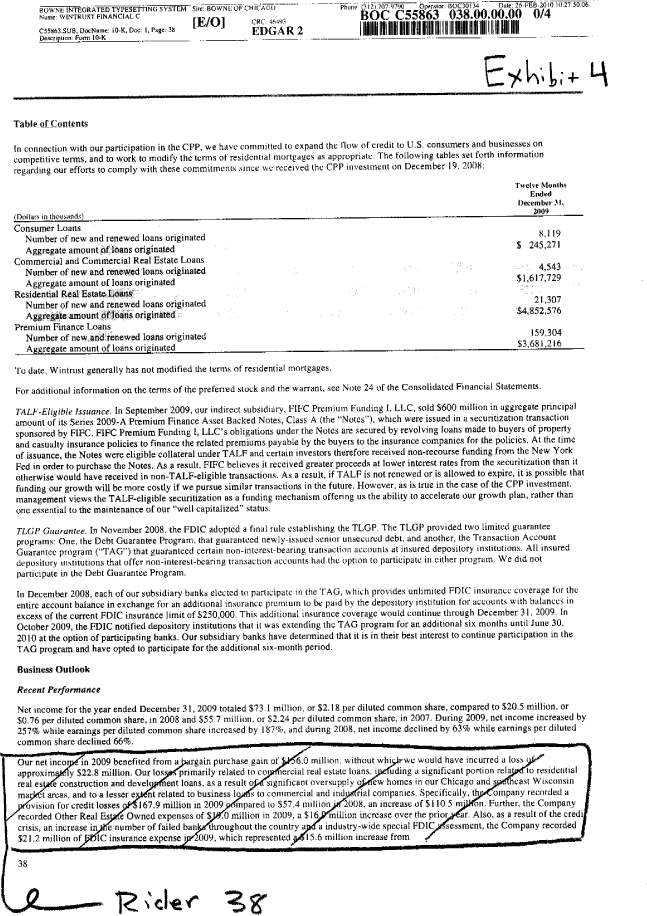
| Table «f Contents In connection with our participation in the CPP, we have committed to expand the I’tow of credit to U.S. consumers and businesses on competitive terms, and to work to modify the terms of residential mortgages as appropriate. The following tables set forth information regarding our efforts to comply with these commitments since we received the CPP investment on December 19, 2008: Twelve Munlhs Ended December 31, (Dollars in thousands) ___ ___—_ — ___— — — Consumer Loans a 11 o Number of new and renewed loans originated 14s 971 Aggregate amount of ioans originated * 24~• Commercial and Commercial Real Estate Loans 4 tji Number of new and renewed loans originated ti A17 7?q Aggregate amount of loans originated * ; ¦ . .. Residential Real Estate Loans ,,. Number of new and renewed loans originated fal as? S7fi AggregMe amount of loans originated *4,8SAS/ti Premium Finance Loans Number of newjnd renewed loans originated — * Aggregate amount of loans originated ___“‘°° ‘ To date, Wintrust generally has not modified the terms of residential mortgages. For additional information on the terms of the preferred stock and the warrant, see Note 24 of the Consolidated Financial Statements. TALI—Eligible Issuance, In September 2009, our indirect subsidiary, F1FC Premium Funding I, LLC, sold $600 million in aggregate principal amount of its Series 2009-A Premium Finance Asset Backed Notes, Class A (the “Notes”), which were issued in a securitization transaction sponsored by FIFC. FIFC Premium Funding 1, LLC’s obligations under the Notes are secured by revolving loans made to buyers of property and casualty insurance policies to finance the related premiums payable by the buyers to the insurance companies for the policies. At the lime of issuance, the Notes were eligible collateral under TALF and certain investors therefore received non-recourse funding from the New York Fed in order to purchase the Notes. As a result, FIFC believes it received greater proceeds at lower interest rates from the securitization than it otherwise would have received in non-TALF-eligible transactions. As a result, if TALF is not renewed or is allowed to expire, it is possible that funding our growth will be more costly if we pursue similar transactions in the future. However, as is true in the case of the CPP investment, management views the TALF-eligible securitization as a funding mechanism offering us the ability to accelerate our growth plan, rather than one essential to the maintenance of our “well capitalized” status, TLGI’ Guarantee. In November 2008, the FDIC adopted a final rule establishing the TLGP. The TLGF provided two limited guarantee programs: One, the Debt Guarantee Program, that guaranteed newly-issued senior unsecured debt, and another, the Transaction Account Guarantee program (“TAG”) that guaranteed certain non-interest-bearing transaction accounts at insured depository institutions. All insured depository institutions that offer non-interest-bearing transaction accounts had the option to participate in either program. We did not participate in the Debt Guarantee Program. In December 2008, each of our subsidiary banks elected to participate in the TAG, which provides unlimited FDIC insurance coverage for the entire account balance in exchange for an additional insurance premium to be paid by the depository institution lor accounts with balances in excess of the current FDIC insurance limit of $250,000. This additional insurance coverage would continue through December 31, 2009. In October 2009, the FDIC notified depository institutions that it was extending the TAG program for an additional six months until June 30, 2010 at the option of participating banks. Our subsidiary banks have determined that it is in th eir best interest to continue participation in the TAG program and have opted to participate for the additional six-month period. Business Outlook Recent Performance Net income for the year ended December 31, 2009 totaled $73.1 million, or $2.18 per diluted common share, compared to $20.5 million, or $0,76 per diluted common share, in 2008 and $55.7 million, or $2.24 per diluted common share, in 2007. During 2009, net income increased by 257% while earnings per diluted common share increased by 187%, and during 2008, net income declined by 63% while earnings per diluted common share declined 66%. ....J_^^—m^m—^-^^___^. . .^^^^—^^— Our net income’ln 2009 benefited from abargain purchase gain ofj^56.0 million, without whic>we would have incurred a lossoj^ I approximately $22.8 million. Our losj^Sprimarily related to commercial real estate loansopefuding a significant portion relaJ^dTo residential I real esLaftconstruction and development loans, as a result insignificant oversupply q£*(ew homes in our Chicago andsp*rfneast Wisconsin I market areas, and to a lesser extent related to business loads to commercial and industrial companies. Specifically, the/Company recorded a | provision for credit losses pP$167.9 million in 2009 compared to $57.4 milliotyirJ2008, an increase of $110.5 mjJ>(on. Further, the Company I /recorded Other Real EsyrteOwned expenses of $J^0 million in 2009, a $1 ^million increase over the prior^ar. Also, as a result of the credif tte number of failed bankrf’throughout the country apda industry-wide special FDlC^fssessment, the Company recorded I 2 insurance expense jp^2()()9, which represented^a^nS.Ci million increase from / J IJIin ‘ |
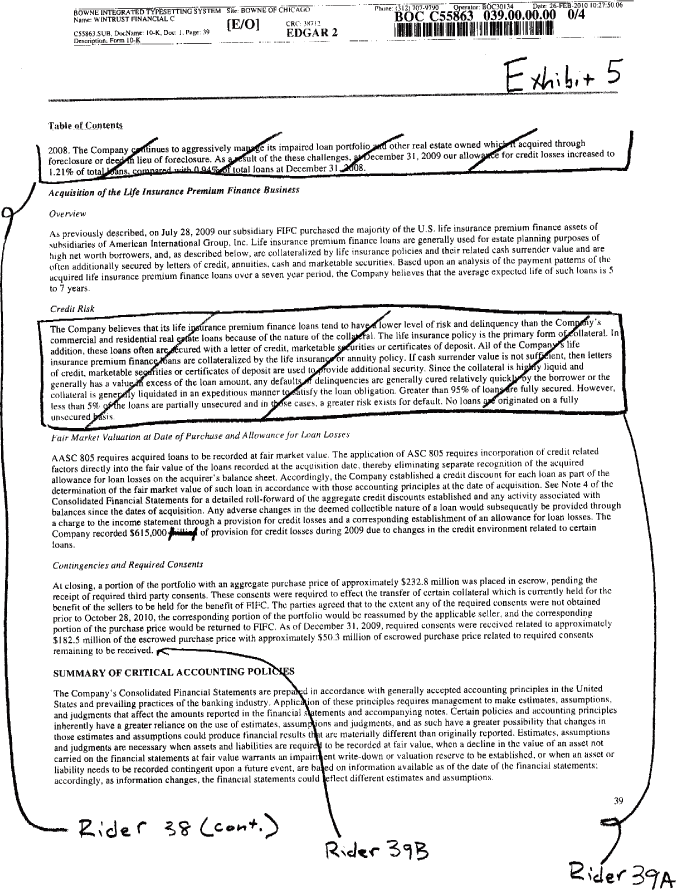
| Table.ofCon wn*s ^ \ 2008 The Company cjrf^ues to aggressively maM^c^ ,, / I roreclosure or dee^mlTeu of foreclosure. Asa^uUof the these challenges^cember 31, 2009 our allowy*Tfor credit losses increased to i I l.21%oftotaj(i^s,cnmpiirr^“th“Q4T’^ ^ — “ ‘ / Acquisition of the Life Insurance Premium Finance Business \J^ Overview I As previously described, on July 28, 2009 our subsidiary RFC purchased the majority of the U.S. life insurance premium finance assets of / subsidiaries of American International Group, Inc. Life insurance premium finance loans arc generally used tor estate planning purposes of / high net worth borrowers, and, as described below, are collaterally by life insurance policies and their related cash surrender value and are often additionally secured by letters of credit, annuities, cash and marketable securities. Based upon an analysis of the payment patterns of inc. acquired life insurance premium finance loans over a seven year period, the Company believes that the average expected life of such loans is 5 to 7 years. V The Company believes that its life inrfjrance premium finance loans tend to have/Iowcr level of risk and delinquency than the Corr^y\s~"~l commercial and residential real tptale loans because of the nature of the corral. The life insurance policy “the primary form of/fillaleral. In addition, these loans often areyfecured with a letter of credit, marketable amities or certificates of deposit. All of the Compan/s life insurance premium finances are eollateralized by the life ¦n.unn/fjr annuity policy. If cash surrender value is not sufttfent then letters of credit marketable searfrities or certificates of deposit are used to^fovide additional security. Since the collateral is hmtfy liquid and generally has a valu Jffexcess of the loan amount, any defauIts/Fdelinquencies arc generally cured relatively quickly the borrower or the collateral is genet^uy liquidated in an expeditious manner tailfilwfy the loan obligation. Greater than 95% of loans^re fully secured However, less than 5% gH!ne loans are partially unsecured and initodse cases, a greater risk exists for default. No loans yforiginated on a fully ^ Fair Market Valuation at Dale of Purchase and Allowance for Lian Losses \ AASC 80”! requires acquired loans to be recorded at fair market value. The application of ASC 805 requires incorporation of credit related \ factors directly into the fair value of the loans recorded at the acquisition date, thereby eliminating separate recognition ol the acquired \ allowance for loan losses on the acquirer’s balance sheet. Accordingly, the Company established a credit discount tor each loan as part of the I determination of the fair market value of such loan in accordance with those accounting principles at the date of acquisition, bee Note 4 of the \ Consolidated Financial Statements for a detailed roll-forward of the aggregate credit discounts established and any activity associated with \ balances since the dates of acquisition. Any adverse changes in the deemed collectible nature of a loan would subsequently be provided through \ a charge to the income statement through a provision for credit losses and a corresponding establishment of an allowance for loan losses. I he \ Company recorded $615,000 fiiiiU of provision for credit losses during 2009 due to changes in the credit environment related to certain \ loans. 1 Contingencies and Required Consents At closing, a portion of the portfolio with an aggregate purchase price of approximately $232.8 million was placed in escrow, pending the receipt of required third party consents. These consents were required to effect the transfer of certain collateral which is currently held tor the benefit of the sellers to be held for the benefit of FIFC. The parties agreed that to the extent any of the required consents were not obtained prior to October 28 2010, the corresponding portion of the portfolio would be reassumed by the applicable seller, and the corresponding portion of the purchase price would be returned to FIFC. As of December 31, 2009, required consents were received related to approximately SI 82.5 million of the escrowed purchase price with approximately $50.3 million of” escrowed purchase price related to required consents remaining to be received. |i~ SUMMARY OF CRITICAL ACCOUNTING POLKMES The Company’s Consolidated Financial Statements are prepaW in accordance with generally accepted accounting principles in the United I States and prevailing practices of the banking industry. Application of these principles requires management to make estimates, assumptions, I and judgments that affect the amounts reported in the financial statements and accompanying notes. Certain policies and accounting principles I inherently have a greater reliance on the use of estimates, assumptions and judgments, and as such have a greater possibility that changes in 1 those estimates and assumptions could produce financial results trfct arc materially different than originally reported. Estimates, assumptions 1 and judgments are necessary when assets and liabilities are requireV to be recorded at fair value, when a decline in the value of an asset not I carried on the financial statements at fair value warrants an impairment write-down or valuation reserve to be established, or when an asset or 1 liability needs to be recorded contingent upon a future event, are baled on information available as of the dale ol” the financial statements; I 1 accordingly, as information changes, the financial statements could fctlect different estimates and assumptions |
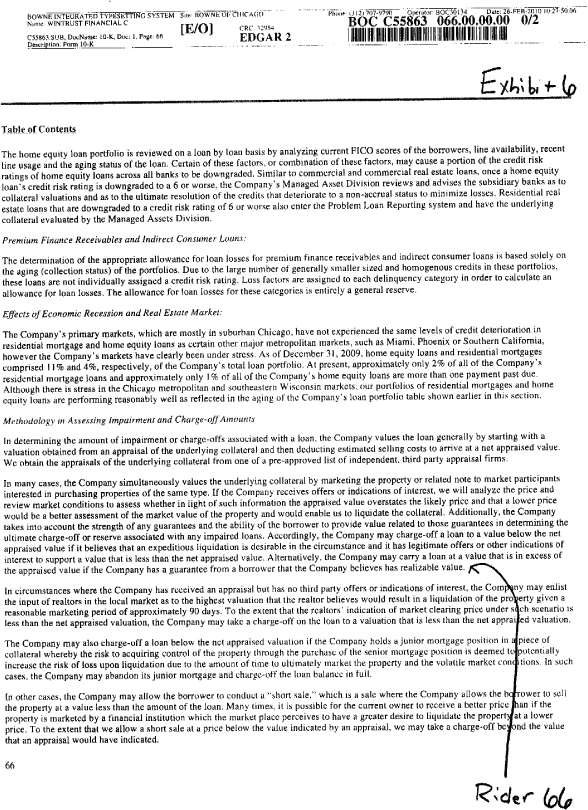
| The home equity loan portfolio is reviewed on a loan by loan basis by analyzing current F1CO scores of the borrowers, line availability, recent line usage and the aging status of the loan. Certain of these factors, or combination of these factors, may cause a portion of the credit risk ratings of home equity loans across all banks to be downgraded. Similar to commercial and commercial real estate loans, once a home equity loan’s credit risk rating is downgraded to a 6 or worse, the Company’s Managed Asset Division reviews and advises the subsidiary banks as to collateral valuations and as to the ultimate resolution of the credits that deteriorate to a non-accrual status to minimize losses. Residential real estate loans that are downgraded to a credit risk rating of 6 or worse also enter the Problem Loan Reporting system and have the underlying collateral evaluated by the Managed Assets Division. Premium Finance Receivables and Indirect Consumer Loans: The determination of the appropriate allowance for loan losses for premium finance receivables and indirect consumer loans is based solely on the aging (collection status) of the portfolios. Due to the large number of generally smaller sized and homogenous credits in these portfolios, these loans are not individually assigned a credit risk rating. Loss factors are assigned to each delinquency category in order to calculate an allowance for loan losses. The allowance for loan losses for these categories is entirely a general reserve. Effects of Economic Recession and Real Estate Market; The Company’s primary markets, which are mostly in suburban Chicago, have not experienced the same levels of credit deterioration in residential mortgage and home equity loans as certain other major metropolitan markets, such as Miami, Phoenix or Southern California, however the Company’s markets have clearly been under stress. As of December 31, 2009, home equity loans and residential mortgages comprised 11% and 4%, respectively, of the Company’s total loan portfolio. At present, approximately only 2% of all of the Company’s residential mortgage loans and approximately only I % of all of the Company’s home equity loans are more than one payment past due. Although there is stress in the Chicago metropolitan and southeastern Wisconsin markets, our portfolios of residential mortgages and home equity loans are performing reasonably well as reflected in the aging of the Company’s loan portfolio table shown earlier in this section. Methodology in Assessing Impairment and Charge-off Amounts In determining the amount of impairment or chargc-offs associated with a loan, the Company values the loan generally by starting with a valuation obtained from an appraisal of the underlying collateral and then deducting estimated selling costs to arrive at a net appraised value. Wc obtain the appraisals of the underlying collateral from one of a pre-approved list of independent, third party appraisal firms. In many cases, the Company simultaneously values the underlying collateral by marketing the property or related note to market participants interested in purchasing properties of the same type. If the Company receives offers or indications of interest, we will analyze the price and review market conditions to assess whether in light of such information the appraised value overstates the likely price and that a lower price would be a better assessment of the market value of the property and would enable us to liquidate the collateral. Additionally, the Company takes into account the strength of any guarantees and the ability of the borrower to provide value related to those guarantees in determining the ultimate charge-off or reserve associated with any impaired loans. Accordingly, the Company may charge-off a loan to a value below the net appraised value if it believes that an expeditious liquidation is desirable in the circumstance and it has legitimate of fers or other indications of interest to support a value that is less than the net appraised value. Alternatively, the Company may carry a loan at a value that is in excess of the appraised value if the Company has a guarantee from a borrower that the Company believes has realizable value, ^^v In circumstances where the Company has received an appraisal but has no third parly offers or indications of interest, the Company may enlist the input of realtors in the local market as to the highest valuation that the realtor believes would result in a liquidation of the property given a reasonable marketing period of approximately 90 days. To the extent that the realtors’ indication of market clearing price under si ch scenario is less than the net appraised valuation, the Company may take a charge-off on the loan to a valuation that is less than the net apprai ed valuation. The Company may also charge-off a loan below the net appraised valuation if the Company holds a junior mortgage position in a piece of collateral whereby the risk to acquiring control of the properly through the purchase of the senior mortgage position is deemed to potentially increase the risk of loss upon liquidation due to the amount of time to ultimately market the property and the volatile market coin itions. In such cases, the Company may abandon its junior mortgage and charge-off the loan balance in full. In other cases, the Company may allow the borrower to conduct a “short sale,” which is a sale where the Company allows the bolhower to sell the property at a value less than the amount of the loan. Many times, it is possible for the current owner to receive a better price lhan if the property is marketed by a financial institution which the market place perceives to have a greater desire to liquidate the propert Jat a lower price. To the extent that we allow a short sale at a price below the value indicated by an appraisal, wc may take a charge-off bejond the value that an appraisal would have indicated. I 6fi I |
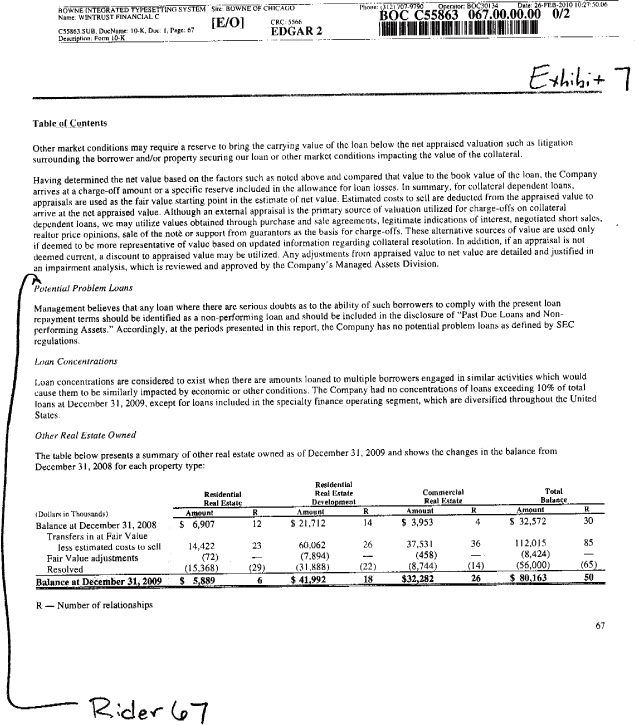
| Table ol Contents Other market conditions may require a reserve to bring the carrying value of the loan below the net appraised valuation such as litigation surrounding the borrower and/or property securing our loan or other market conditions impacting the value of the collateral. Having determined the net value based on the factors such as noted above and compared that value to the book value of the loan, the Company arrives at a charge-off amount or a specific reserve included in the allowance for loan losses. In summary, tor collateral dependent loans, appraisals are used as the fair value starting point in the estimate of net value. Estimated costs to sell are deducted from the appraised value to arrive at the net appraised value. Although an external appraisal is the primary source of valuation utilized for charge-offs on collateral dependent loans we may utilize values obtained through purchase and sale agreements, legitimate indications of interest, negotiated short sales, realtor price opinions, sale of the nol6 or support from guarantors as the basis for charge-offs. These alternative sources of value are used only if deemed to be more representative of value based on updated information regarding collateral resolution. In addition, it an appraisal is not deemed current, a discount to appraised value may be utilized. Any adjustments from appraised value to net value are detailed and justified in an impairment analysis, which is reviewed and approved by the Company’s Managed Assets Division. / Potential Problem Loans Management believes that any loan where there are serious doubts as to the ability of such borrowers to comply with the present loan repayment terms should be identified as a non-performing loan and should be included in the disclosure of “Past Due Loans and Non-performing Assets.” Accordingly, at the periods presented in this report, the Company has no potential problem loans as defined by SEC regulations. I Loan Concentrations I Loan concentrations are considered to exist when there are amounts loaned to multiple borrowers engaged in similar activities which would I cause them to be similarly impacted by economic or other conditions. The Company had no concentrations of loans exceeding 10% of total / loans at December 31, 2009, except for loans included in the specialty finance operating segment, which are diversified throughout the United I States. Other Real Estate Owned The table below presents a summary of other real estate owned as of December 31, 2009 and shows the changes in the balance from December 31, 2008 for each property type: Residential Residential Real Estate Commercial Total Real Estate Development Real Kstate Balance (Dollars in Thousands) Amount R Amount R Amount R Amount R Balance at December 31,2008 $6,907 12 $21,712 14 $3,953 4 $32,572 30 Transfers in at Fair Value ,,,,,,, ., less estimated costs to sell 14,422 23 60,062 26 37,531 36 112,015 85 Fair Value adjustments (72) ___(7,894) — (458) — (8,424 — Resolved (15,368) (29) (31,888) (22) (8,744) (14) (56,000) (65) Balance at December 31,2009 $S,889 6 $41,992 18 $32,282 26 $80,163 50 I R — Number of relationships 67 |